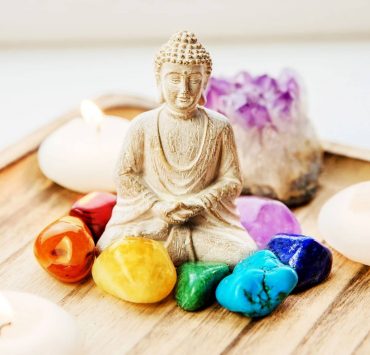
Former nutrition specialist Alexandra Mackenzie knows what it means to…
Some traditional yogic philosophy concepts have made their way into the modern world. The idea of karma, for example, is generally understood by even those who don’t practice yoga.
Samskara isn’t often mentioned in modern postural yoga classes. But it’s an important part of yogic philosophy to understand to truly get the most of the mind and body practice that is yoga.
In the yogic worldview, life is non-dual. Meaning, there is no positive or negative. However, your mind compartmentalizes experiences into good and bad. This is what makes you stuck in certain patterns or habits.
These patterns can be repeated throughout your entire life and may have even been carried over from previous lifetimes. Your past reactions shape your current world. This puts you into a groove, so to speak, which may be difficult to change.
But through proper study of yogic concepts like samskara, you can help yourself break free and change your life with a few simple and attainable steps.
What are Samskaras and How do They Affect Us?

Samskara is a concept made up of two words: sam, which means complete or joined together. And kara, which means action, cause, or doing.
According to popular Indian spiritual leader, Sadhguru, you need to understand samskara in relation to two other important concepts in yogic spirituality: karma and vasana.
Sadhguru explained that karma are the accumulated imprints or impressions left from previous actions. This can be from your present life or previous ones. Experiences on their own, in the yogic worldview, are neither positive nor negative. It’s how you react to them which creates duality and your karma.
Karma can be repeated over many lifetimes. But if you are willing, you can also change your karma at any time.
Your karma gets carried over throughout your life and reincarnations. And these create residue called vasana. Literally, this Sanskrit word translates as “smell.” But a more accurate translation into English is your tendency.
For example, if you have the scent of a flower, you will have the tendency to attract butterflies and bees and other beneficial pollinators. On the other hand, if you have the scent of rotting meat, you will have the tendency to attract flies which will produce maggots.
Your tendencies will determine the kind of people and experiences you attract, and the kind of life you lead.
Finally, samskara is the consequence of karma and vasana. You can also think of them as deep impressions — like how a path is created through grass when people walk over it enough times regularly.
You are born into a certain samskara because of habits from previous lifetimes. But your present karma determines how much you live in joy or in suffering.
As Sadhguru also explained, because of your samskara, you may be born in a palace. But your karma may cause you to see only suffering. On the other hand, you may be born in a slum because of your samskara, but your karma lets you take in only joy.
One of the most important take-aways from this understanding of how karma, vasana, and samskara inter-relate is: you can change your samskara — but it will not change instantly. You have to work at it with discipline and determination to break free of habits and patterns formed over many lifetimes.
In a practical sense, it’s just like neurobiology. Your brain already has established pathways because of your habits and your preference for the way you learn and live your life. But these are not fixed. Neuroplasticity proves that your brain can create new pathways through the regular practice of new patterns.
This can happen only when you are willing to do the work to make that change.
Negative Samskaras According to the Yoga Sutras of Patanjali

The Yoga Sutras of Patanjali is one of the most important texts to survive from medieval India which explains yogic philosophy.
Patanjali was a sage, who may or may not be mythical, who compiled the verses on yoga which were previously memorized passed down through oral tradition from guru to disciple.
These sutras, or threads, include an explanation on negative samskaras, or the scars of samskara. These are 9 predictable obstacles which may prevent you from progressing towards samadhi, or enlightenment.
- Illness/physical disease
- Laziness/mental dullness/procrastination
- Doubt/indecision
- Lack of attention/carelessness/negligence
- Lack of enthusiasm/apathy/sloth
- Sensuality/cravings/sexual indulgence
- False perception/confusion
- Failure to attain/progress
- Inability to maintain concentration; inconstancy; instability
12 Steps to Break Free
It takes work to break free of negative samskaras, but it is attainable. Here are 12 steps that can help you create a roadmap to change your life.
1. Abhyasa – Regular Practice

Regular practice is the only way to create new pathways. And all spiritual disciplines stress the importance of setting up a routine for spiritual practices. Even the most gifted of musicians must set aside a few minutes of their day to practice their craft. If you want to break free of your old habits, you must routinely practice the new ones you want to replace them with.
2. Recognize That Obstacles Are a Natural Part of Life and You Can Overcome Them
The first step to create any change is to recognize that something must change. And there is no need to create any guilt or shame around this recognition. Simply acknowledge that this is how your life has been and you are making a conscious decision to transform it.
3. Practice Shani – Slowing Down to Intuit
Shani is the practice of slowing down your tendency to react impulsively. Slowing down allows you to tune in to your intuition better. It allows you to be more mindful and introspect before deciding to act.
4. Start a Journal
Journaling is an excellent way to practice shani in a concrete way. Even if you’re not able to slow down when you’re in the heat of the moment, so to speak, you can still slow down when you take time at the start or end of the day to reflect and write down your observations and impressions of your experiences.
5. Meditate

Meditation is one of the branches of yoga which is sometimes overlooked in modern postural yoga classes. Studies show that regular meditation helps create new neural pathways. Former connections which used to make you feel anxiety decrease and pathways which will help keep calm and level-headed even in challenging situations will form.
6. Discern Vidya – Awareness or Clear Seeing
Vidya refers to knowledge. There are two kinds of knowledge, which are vidyā (valid knowledge) and avidyā (invalid knowledge). Proper discernment of these two kinds of knowledge will help you recognize more clearly what creates obstacles in your life, what tendencies or habits you have, and what patterns need to be changed.
7. Abhaya – Fearlessness
Fear of change and fear of the unknown is often the biggest hurdle when it comes to breaking free of old habits. Sometimes, even bad habits are easier to keep because they are comfortable. The scariest part of transformation is you don’t necessarily know if your life will be better after committing to change. But to make the conscious decision to live with Abhaya, or fearlessness, will enable you to face the unknown, which is inevitable when ending a familiar pattern.
8. Sankalpa – Setting Positive Intention
A clear intention will help you more clearly see your goal. This sankalpa should resonate with you on a deeper level so that even when you are faced with a challenge on your journey, you can always go back to your positive intention and remember what you want to achieve.
9. Set Mini-Goals and Reminders For Yourself of What You Can Replace Old Habits With
Allow yourself to progress in baby steps. You can do this with mini-goals that will help you work your way towards your sankalpa. For example, instead of getting stuck on how deep the trench you’re stuck in is, allow yourself the time and patience to dig yourself out one spoonful of dirt at a time. Instead of lamenting on how high the ladder you must climb is, allow yourself to celebrate every single rung at a time.
10. Connect with Others Who Are Also Going Through A Conscious Decision To Change

Community is important for support and accountability when you decide to change your life. Sharing your experiences and learning from the challenges others had to face may help you navigate your path more easily. Surround yourself with people who will help you stick to your decision to transform your life and break free of repeated patterns that no longer serve you.
11. Set a Time Daily for Asana, Meditation, or Other Self-Care and Spiritual Practice
Part of changing your life should include a regular spiritual and self-care practice to help keep you on track. Daily yoga asana, meditation, or even something as simple as drinking a hot cup of tea in silence is enough to help your system slow down to appreciate the progress you’ve made no matter how big or small.
12. Allow Yourself to Make Mistakes
Mistakes may happen as you go through this process. You may consciously or unconsciously fall back into your old habits. This is normal and you should not feel sad or guilty about it. Instead, take a pause, forgive yourself, and check in if you need to make adjustments to your plan.
Just like Sadhguru explained, samskara cannot be changed 100% instantly. But what you can change right now is your karma — or how you react to life. If you can react without creating drama, then you allow yourself to help shape your new samskara.
Conclusion

Facilitating change in your own life can be daunting. But proper understanding of your samskara, and how it is a natural, inevitable part of life, can help you get on the path to break free.
Your current samskara is the fruit of many lifetimes of karma and vasana. If you are stuck in one of the 9 negative samskaras, know that you are not alone and you don’t have to resign yourself to this fate forever.
With patience and willingness to do the work, you can change your karma, develop new patterns, new neural connections, and over time, transform your samskara into a positive life.
What's Your Reaction?
Former nutrition specialist Alexandra Mackenzie knows what it means to support the body and mind through food. She’s passionate about sharing her wealth of knowledge with anyone willing to listen.














